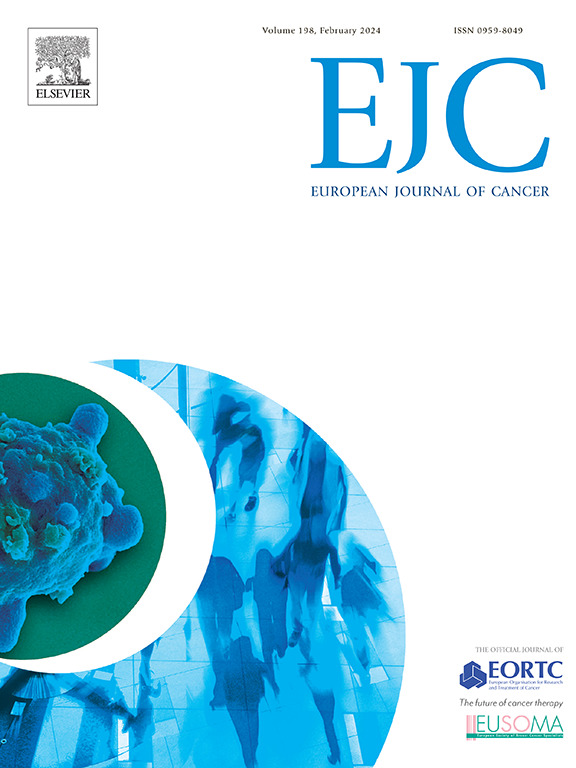原发性腹膜后肉瘤的放射学特征:预后研究。
IF 7.6
1区 医学
Q1 ONCOLOGY
引用次数: 0
摘要
背景:腹膜后肉瘤(RPS)患者的风险分级依赖于经过验证的提名图,如 Sarculator。这项回顾性研究探讨了从计算机断层扫描(CT)成像中提取的放射学特征是否能:i)提高 Sarculator 的性能;ii)识别 G3 级低分化脂肪肉瘤(DDLPS)或leiomyosarcoma(LMS):纳入接受治愈性手术治疗的原发性局部RPS患者(2011-2015年),并提供术前CT成像。人工标注未增强和门静脉相采集的感兴趣区(ROI)。通过生成复制实验(上下文),将患者分成训练集和测试集,利用结果特异性随机森林模型选出表现最佳的放射学特征。终点是总生存期和无病生存期(OS、DFS)。DFS和OS的预后模型包括前五个选定的放射学特征和Sarculator提名图评分。模型的准确性通过哈雷尔一致性(C-)指数进行评估:研究共纳入 112 名患者,中位随访时间为 77 个月(IQR 65-92 个月)。单用 Sarculator 计算的 DFS 和 OS 的 C 指数分别为 0.622 和 0.686。放射学特征仅略微提高了 Sarculator 对 OS(C-index=0.726,C-index gain:0.04)或 DFS(C-index=0.639,C-index gain:0.017)的预测准确性。最后,放射学特征识别 G3 DDLPS 或 LMS 患者的准确率为 0.806:结论:放射学特征略微提高了 Sarculator 在 RPS 中的性能。然而,它们能在诊断时准确识别出 G3 DDLPS 或 LMS,从而有可能改善患者对新辅助治疗的选择。本文章由计算机程序翻译,如有差异,请以英文原文为准。
Radiomic features of primary retroperitoneal sarcomas: a prognostic study
Background
Risk-stratification of patients with retroperitoneal sarcomas (RPS) relies on validated nomograms, such as Sarculator. This retrospective study investigated whether radiomic features extracted from computed tomography (CT) imaging could i) enhance the performance of Sarculator and ii) identify G3 dedifferentiated liposarcoma (DDLPS) or leiomyosarcoma (LMS), which are currently consider in a randomized clinical trial testing neoadjuvant chemotherapy.
Methods
Patients with primary localized RPS treated with curative-intent surgery (2011–2015) and available pre-operative CT imaging were included. Regions of interest (ROIs) were manually annotated on both unenhanced and portal venous phase acquisitions. Top performing radiomic features were selected with outcome-specific random forest models, through generation of replicative experiments (contexts) where patients were split into training and testing sets. Endpoints were overall and disease-free survival (OS, DFS).
Prognostic models for DFS and OS included the top five selected radiomic features and the Sarculator nomogram score.
Models accuracy was assessed with Harrell’s Concordance (C-)index.
Results
The study included 112 patients, with a median follow-up of 77 months (IQR 65–92 months).
Sarculator alone achieved a C-index of 0.622 and 0.686 for DFS and OS, respectively. Radiomic features only marginally enhanced the prediction accuracy of Sarculator for OS (C-index=0.726, C-index gain: 0.04) or DFS (C-index=0.639, C-index gain: 0.017). Finally, radiomic features identified patients with G3 DDLPS or LMS with an accuracy of 0.806.
Conclusion
Radiomic features marginally improved the performance of Sarculator in RPS.
However, they accurately identified G3 DDLPS or LMS at diagnosis, potentially improving patients selection for neoadjuvant treatments.
求助全文
通过发布文献求助,成功后即可免费获取论文全文。
去求助
来源期刊

European Journal of Cancer
医学-肿瘤学
CiteScore
11.50
自引率
4.80%
发文量
953
审稿时长
23 days
期刊介绍:
The European Journal of Cancer (EJC) serves as a comprehensive platform integrating preclinical, digital, translational, and clinical research across the spectrum of cancer. From epidemiology, carcinogenesis, and biology to groundbreaking innovations in cancer treatment and patient care, the journal covers a wide array of topics. We publish original research, reviews, previews, editorial comments, and correspondence, fostering dialogue and advancement in the fight against cancer. Join us in our mission to drive progress and improve outcomes in cancer research and patient care.
 求助内容:
求助内容: 应助结果提醒方式:
应助结果提醒方式:


